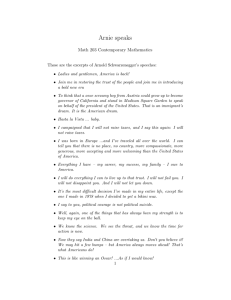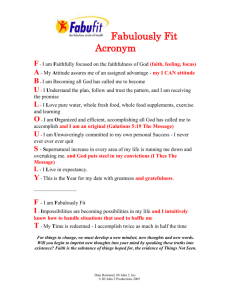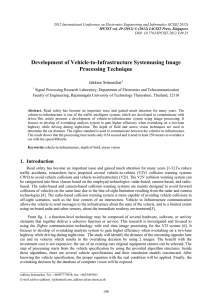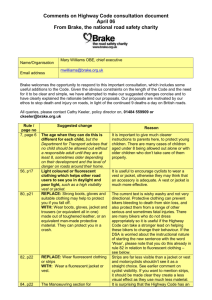Research Journal of Applied Sciences, Engineering and Technology 4(20): 4022-4027,... ISSN: 2040-7467
advertisement
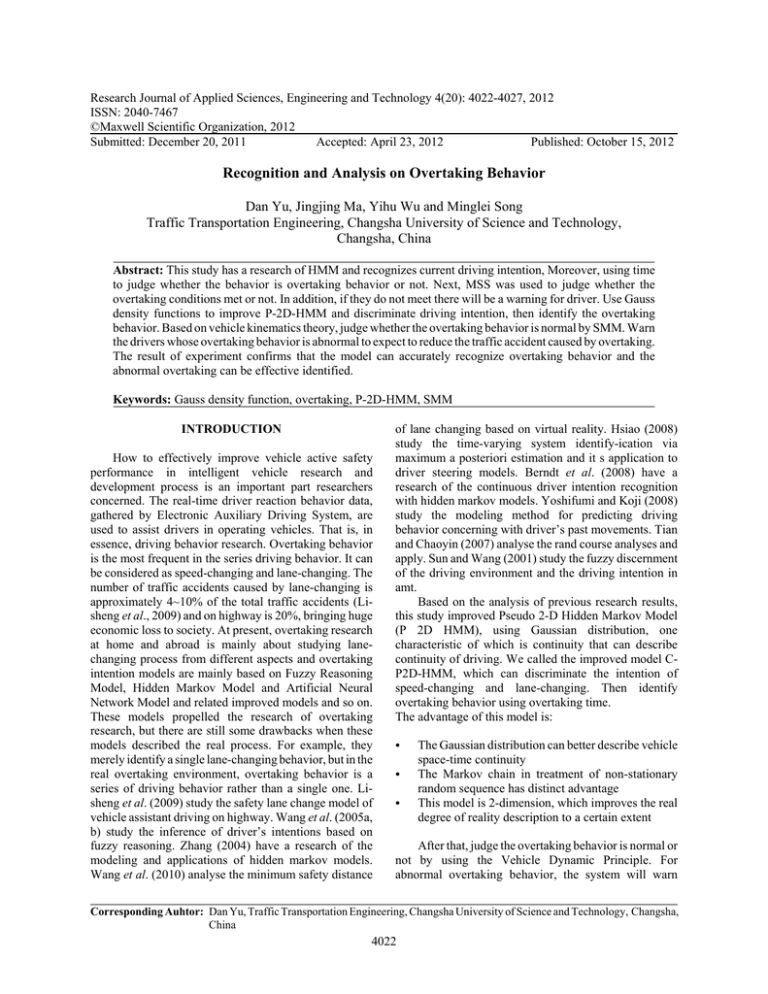
Research Journal of Applied Sciences, Engineering and Technology 4(20): 4022-4027, 2012
ISSN: 2040-7467
©Maxwell Scientific Organization, 2012
Submitted: December 20, 2011
Accepted: April 23, 2012
Published: October 15, 2012
Recognition and Analysis on Overtaking Behavior
Dan Yu, Jingjing Ma, Yihu Wu and Minglei Song
Traffic Transportation Engineering, Changsha University of Science and Technology,
Changsha, China
Abstract: This study has a research of HMM and recognizes current driving intention, Moreover, using time
to judge whether the behavior is overtaking behavior or not. Next, MSS was used to judge whether the
overtaking conditions met or not. In addition, if they do not meet there will be a warning for driver. Use Gauss
density functions to improve P-2D-HMM and discriminate driving intention, then identify the overtaking
behavior. Based on vehicle kinematics theory, judge whether the overtaking behavior is normal by SMM. Warn
the drivers whose overtaking behavior is abnormal to expect to reduce the traffic accident caused by overtaking.
The result of experiment confirms that the model can accurately recognize overtaking behavior and the
abnormal overtaking can be effective identified.
Keywords: Gauss density function, overtaking, P-2D-HMM, SMM
INTRODUCTION
How to effectively improve vehicle active safety
performance in intelligent vehicle research and
development process is an important part researchers
concerned. The real-time driver reaction behavior data,
gathered by Electronic Auxiliary Driving System, are
used to assist drivers in operating vehicles. That is, in
essence, driving behavior research. Overtaking behavior
is the most frequent in the series driving behavior. It can
be considered as speed-changing and lane-changing. The
number of traffic accidents caused by lane-changing is
approximately 4~10% of the total traffic accidents (Lisheng et al., 2009) and on highway is 20%, bringing huge
economic loss to society. At present, overtaking research
at home and abroad is mainly about studying lanechanging process from different aspects and overtaking
intention models are mainly based on Fuzzy Reasoning
Model, Hidden Markov Model and Artificial Neural
Network Model and related improved models and so on.
These models propelled the research of overtaking
research, but there are still some drawbacks when these
models described the real process. For example, they
merely identify a single lane-changing behavior, but in the
real overtaking environment, overtaking behavior is a
series of driving behavior rather than a single one. Lisheng et al. (2009) study the safety lane change model of
vehicle assistant driving on highway. Wang et al. (2005a,
b) study the inference of driver’s intentions based on
fuzzy reasoning. Zhang (2004) have a research of the
modeling and applications of hidden markov models.
Wang et al. (2010) analyse the minimum safety distance
of lane changing based on virtual reality. Hsiao (2008)
study the time-varying system identify-ication via
maximum a posteriori estimation and it s application to
driver steering models. Berndt et al. (2008) have a
research of the continuous driver intention recognition
with hidden markov models. Yoshifumi and Koji (2008)
study the modeling method for predicting driving
behavior concerning with driver’s past movements. Tian
and Chaoyin (2007) analyse the rand course analyses and
apply. Sun and Wang (2001) study the fuzzy discernment
of the driving environment and the driving intention in
amt.
Based on the analysis of previous research results,
this study improved Pseudo 2-D Hidden Markov Model
(P 2D HMM), using Gaussian distribution, one
characteristic of which is continuity that can describe
continuity of driving. We called the improved model CP2D-HMM, which can discriminate the intention of
speed-changing and lane-changing. Then identify
overtaking behavior using overtaking time.
The advantage of this model is:
C
C
C
The Gaussian distribution can better describe vehicle
space-time continuity
The Markov chain in treatment of non-stationary
random sequence has distinct advantage
This model is 2-dimension, which improves the real
degree of reality description to a certain extent
After that, judge the overtaking behavior is normal or
not by using the Vehicle Dynamic Principle. For
abnormal overtaking behavior, the system will warn
Corresponding Auhtor: Dan Yu, Traffic Transportation Engineering, Changsha University of Science and Technology, Changsha,
China
4022
Res. J. Appl. Sci. Eng. Technol., 4(20): 4022-4027, 2012
A
M
M
F
F
M
F
o ver t aki n g t i me
a、 ove r t ak i ng i n t he opp osi t e di r ect i on l ane
A
M
F
M
M
F
F
o ver t aki n g t i me
b、 ove r t ak i ng i n t he s ame di r e ct i o n l a ne
o bj ec t i ve
M
v ehi c l e
F
o ver t aken
v ehi c l e
Fig. 1: Overtaking condition schemes
The 1st land change time (t1) A The 2nd land change time (t2)
B
Fig. 2: Overtaking trajectory scheme
driver. In which way the number of traffic accidents
maybe decline.
OVERTAKING BEHAVIOR IDENTIFICATION
Overtaking condition: The condition of driving directly
affects driver's driving behavior. For the overtaking
behavior, this study will divide overtaking condition into
two parts, overtaking in the opposite direction lane and in
the same direction lane. The former is using reverse fast
lane overtake vehicle F, which usually occurs in the urban
road without intervening belt; the later is using
coincidental lane overtake vehicle F from left lane, as
shown in Fig. 1. Although overtaking from right is illegal
(Fig. 2), there are still some drivers holding fluky
psychology. These behaviors bring traffic safety huge
hidden trouble.
Driving intention recognition mode l: Overtaking
intention is not visible, so the vehicle driving process is
usually used to describe it. Driving process has the spacetime continuum and is a series of complex activities
results. In order to facilitate this process, overtaking
behavior is regarded as drivers finishing two times lanechanging and speed-changing in a certain time )t. This
needs to jump out the limits of one dimension and using
two dimension models instead of one dimension is more
reasonable.
P2D-HMM, based on HMM, is an incomplete
statistics model (Zhang, 2004). It is applicable to dynamic
modeling and widely used in domains of face recognition
and character recognition. Its double stochastic process
comprises an invisible finite state 2D markov chain and a
random process. The former can be used to describe the
transfer of overtaking intention and the later can be used
to describe the relationship between overtaking intention
and overtaking behavior, which can use observation
probability to describe. The C-P2D-HMM is based on
P2D-HMM, so the model also has these characters.
Through the transition probability of overtaking intention
the later driving intention can be forecasted.
Related parameters of P2D-HMM: ' = (A, A, B, S, V)
can be used to describe P2D-HMM. A = {Pq}is the initial
probability distribution and Pq = P(X1,1 = q).
A = {Pq|r, Pq|t, Pq|r,s,t } is the transition probability
distribution. Pq|r is the first column of the transition
probability distribution, Pq|r = P(Xm,1 = q|Xm-1,1 = r); Pq|t is
the first line of transition probability distribution, Pq|t =
P(X1,n = q|X1,n-1 = t); and Pq|r,s,t is the others of the transition
probability distribution:
4023
Res. J. Appl. Sci. Eng. Technol., 4(20): 4022-4027, 2012
chang l ane( CL)
keep speed and speed up and
change l ane
change l ane
speed down and
change l ane
keep l ane( CN)
keep speed and speed up and
l ane
keep l ane
speed down and
keep l ane
keep speed( SO) speed up( SU)
speed down( SD)
A = {Pq|r, Pq|t , Pq|r,s,t} is the transition probability
distribution of lane and speed. Pq|r is the transition
probability distribution of keeping speed, Pq|r = P(Xm,1 =
q|Xm-1,1 = r); Pq|t is t transition probability distribution of
keeping lane, Pq|t = P(X1,n = q|X1,n-1 = t); and Pq|r,s,t is the
others of the transition probability distribution:
X m−1,n −1 = s
Pq |r ,s ,t = P( X m,n = q X m,n −1 = t )
X m−1,n = r
⎡ C11 C12 K C1k ⎤
⎢C
C22 K C2 k ⎥
21
⎥
C=⎢
⎢
⎥
K
⎢
⎥
K
C
C
C
j
1
j
2
jk
⎣
⎦
Fig. 3: 2 dimensions of the model
X m−1,n −1 = s
is the mixture weights of
Pq |r ,s,t = P( X m,n = q X m,n −1 = t )
X m−1,n = r
Gaussian density and ∑ c jk = 1, c jk ≥ 0 .
k =1
⎡ µ11
⎢µ
21
µ= ⎢
⎢
⎢
⎣ µ j1
B = {Pq(Hi)} is the observed characteristics probability
distribution:
Pq(H i ) = P(Ym, n = Hi |Xm, n = q)
S = {q, r, ...,w, y, z} is the limited space set.
V = {Hi}is the discrete set of observed characteristics.
In addition, X = XM, N1, 1 = {Xm, n: (m, n),L} is M×N
dimensional state matrix; and Y = YM, N1, 1 = {Ym, n: (m, n)
,L } is M×N dimensional observed characteristics matrix.
Driving intention identify model based on C-P2DHMM: Overtaking behavior can be regarded as the
combination of speed changing and lane changing and the
model’s 2 dimensions can be determined which is based
on the two intentions. Then based on the model, the speed
changing and lane changing can be identified, just as
Fig. 3 shows. Keeping speed and changing lane, speed up
and keeping lane and speed down and keeping lane can be
regarded as 1-dimensional observation sequence
changing, but the other two situations, speed up and
changing lane and speed down and changing lane, need
the 2-dimensional observation sequence changing at the
same time, which the P2D-HMM can meet the
requirements.
And the driving is continuous time behavior, but the
observed characteristics probability distribution B in P2DHMM is discrete distribution. If using the model to
directly identify driving intention, there are must be some
errors in the results. So the P2D-HMM should be
improved. Gaussian mixture probability density is used to
describe the continuous observation sequence. Its
observation vector sequence is O = {O1, O2, ...., OK}.
' = (A, A, C, :, U) can be used to describeC-P2D-HMM.
A = {Pq} is the initial probability distribution of driving
intention and Pq = P(X1,1 = q).
µ12 K µ1k ⎤
µ22 K µ2 k ⎥⎥
is the mean vector of Gaussian
K
µ j2
⎥
⎥
K µ jk ⎦
density.
U is Covariance matrix.
Then driving intentions observation
V probability density function forms is:
sequence
b j (V ) = ∑ c jk b jk (V )
k =1
= ∑ c jk ⋅
k =1
1
1
(O − µ jk ) T (O − µ jk )]
⋅ exp[ −
U
2
2πU jk
jk
Same with HMM, modeling C-P2D-HMM need to
solve learning problems of model, which is to get the
related parameters of the model. Then decode the model
to work out the optimal sequence of hidden states.
This study optimized ( and hidden states by cross
validation between parameters and model. That is initial
parameters (0 is given at first to make sure the most
possible states of meeting the parameters group, then
parameter ( is estimated again in the current condition and
based on which the model state is revalued. Circulate until
conditions of convergence are met. Last calculate ( to get
max P(V|() under the input sequence of drivers’
operations and random initial parameter (0. This study
used 2D Viterbi algorithm to get the optimal state chain.
Overtaking recognition and abnormal overtaking:
Recognize driving intention is to help driver operate
vehicles better. The drive can be warned if the next
identified driving behavior which is abnormal, even using
4024
Res. J. Appl. Sci. Eng. Technol., 4(20): 4022-4027, 2012
the computer to control the vehicle not to execute the
wrong operation. Three logical stages are usually
considered when driver is in overtaking process:
C
C
C
Date
pretreatment
Whether there is overtaking demand or not
Whether overtaking condition is mature or not
Whether overtaking must be taken
Initialization
data
Abnormal overtaking is that in the overtaking process
the drivers overtake when the condition is not mature
because of the divers’ psychological factors, driving
environment factors and so on. But illegal overtaking
doesn’t belong to abnormal overtaking behavior. It takes
huge negative effects to road traffic safety. Abnormal
overtaking may caused scraping among vehicles even
collision and death, which directly affects transportation
capacity. According to Minimum Safety Space (MSS),
whether the overtaking is normal or not is judged. The
MSS between object vehicle M and vehicle A and the
MSS between object vehicle M and vehicle F is
respectively got by using motion characteristics in
overtaking process, just like Fig. 1 show (Wang et al.,
2010):
t λ
MSS ( A, M ) = max{∫0 ∫0 [a M (τ ) − a A (τ )]dτdλ
+ [v M (0) − v A (0)t ,0}
(1)
t λ
MSS ( F , M ) = max{∫0 ∫0 [a M (τ ) − a F (τ )]dτdλ
+ [v M (0) − v F (0)t ,0}
Select data
types
Data
acquisition
(2)
When the two conditions are not met, the overtaking
condition is not considered maturity and the overtaking is
abnormal.
MODEL CONFIRMATION
Figure 4 is the framework of driving intention
recognition that is based on C-P2D-HMM. In the known
sample data, select the first 5/6 data as the training sample
of C-P2D-HMM SXCY and the others as confirmation
sample.
If it contains the lane changing intention in one
driving intention, the time t1 is recorded and the rest can
be done in the same manner t2……tn. An overtaking
behavior is considered if tn-tn-1 , )t. And the range of )t
depends on the lane width, object vehicle speed and
overtaken vehicle speed.
Classification training: If overtaking is in the opposite
direction lane, the input data should consider the space
between object vehicle M and vehicle A, the relative
Driving intention
classification training
based on C-P2D-HMM
Driving intention
recognize based on
C-P2D-HMM
The model whose
log-likelihood value
is max the next
driving intention
Calculate loglikelihood value
Re valuate
parameters
N
Whether
convergence
Y
Keep the
C-P2D-HMM
Fig. 4: The framework of driving intention recognition that is
based on C-P2D-HMM
velocity between object vehicle M and vehicle A and
lateral acceleration of M, but because of limiting of
sample data, the model with this condition will not be
trained.
The sample dada type belonged to overtaking in the
same direction lane. This study used the space between
two vehicles, speed and steering wheel angle three kind
data to get the needing dada. The horizontal speed curve
and horizontal acceleration curve could be got by speed
curve and steering wheel angle curve. So the space
between two vehicles, the objective vehicle speed and the
horizontal acceleration were as input data to train and get
the driving intention recognize model based on C-P2DHMM, namely C-P2D-HMM SUCL, C-P2D-HMM
SUCN, C-P2D-HMM SOCL, C-P2D-HMM SOCN, CP2D-HMM SDCL and C-P2D-HMM SDCN. Then
revaluate the parameters of these models, test whether it
is convergence. If yes, the model could be kept as the
driving intention recognize model based on C-P2DHMM.
Then use the kept models to respectively recognize
the driving intention and use log-likelihood to estimate the
likelihood level of C-P2D-HMM. When iterative result
difference value is less than 10, the model likelihood level
is considered well. All of the sample data were input in
the models respectively and used log-likelihood to
estimate every model. Which model the kind data
belonged to, the current driving intention could be
identified? That solved the estimate problem, which
model is the most possible model under the observation
sequence. Table 1 is a set of driving intention loglikelihood value.
While the sample data was input in the model, the
recognized results we got were shown in the Table 1. It
showed that only one model’s likelihood is largest with a
4025
Res. J. Appl. Sci. Eng. Technol., 4(20): 4022-4027, 2012
Table 1: Log-likelihood value of driving intention based on C-P2D-HMM
SUCL
SUCN
Keep speed and change lane
-105.9903
-124.6652
Keep speed and not change lane
-117.3658
-112.9266
Speed up and change lane
-51.3510
-87.2997
Speed up and not change lane
-78.2587
-59.8041
Speed down and change lane
-103.3685
-114.2206
Speed down and not change lane
-111.3984
-102.7286
v
SOCL
-63.5930
-101.3275
-114.4401
-137.9436
-109.8376
-142.3079
SOCN
-112.0324
-79.0491
-107.2800
-115.2738
-132.8834
-128.7239
SDCL
-133.7730
-121.4217
-114.3396
-105.3587
-81.3349
-115.3019
SDCN
-145.2383
-125.5391
-153.9162
-118.4191
-109.8201
-73.7315
v
a
Fig. 5: The vehicle trajectory
18
Relative velocity (m/s)
set of sample data was input in the model. Speed up and
lane changing as example shown in Table 1, the
homologous data was input in C-P2D-HMM SUCL, then
the log-likelihood was -51.3510. Compared with other
models log-likelihood value, it was the max likelihood
output. So it was ideal classification.
Based on the above result, the driving intention of
next time can be preliminary predicted. While 5s is as the
time interval to divide the sample and the data in the 5s
respectively input to the model, 6 probability value will
get in which the max value is the corresponding driving
intention. The model SUCL as an example, in a certain
time interval, the probability values got from the model
respective are 0.7413, 0.0438, 0.1674, 0.0137, 0.0143 and
0.0195, which means that the next possible operation is
speed up and lane change. All of the sample data were
input the model and the accuracy was about 93.15%
which meant the next driving intention could be
accurately identified. While 3s is as the time interval to
divide the sample and the data in the 3s respectively input
to the model, the accuracy was 95.44%. With the decrease
of the time interval, calculation of the model increased but
the accuracy improved.
Besides considering forecast precision, the model
also needs to consider how earlier before the behavior
operate, namely the prediction ability in advance of the
model.
Predict time in advance = the moment of the actual
behavior happening-the moment of predict driving
intention happening.
It is found that the more Gaussian mixture number is,
the shorter recognizing time needs. When the number is
4, the time is 3.7s and the number is 8, the time is 1.4s.
L2
14
L1
10
6
2
10
30
50
70
ts
90
110
Fig. 6: The critical curve of )t
Overtaking recognize analysis: Recognize overtaking
behavior after predicting the next moment driving
intention. As shown in the Fig. 5, if the time difference of
adjacent two times lane-changing is in the scope of )t, the
overtaking is complete. )t is determined by the
cumulative sum of 3 respective needing times, which are
belong to the first speed-changing and lane-changing, the
second speed-changing and lane-changing and speedchanging and keep-lane. The width of lane in our country
is usually from 3 to 3.5 m, here is 3.2 m. When the
horizontal speed of object vehicle is 0.64 m/s, the needing
time of the first speed-changing and lane-changing and
the second speed-changing and lane-changing is at most
10s. The needing time of speed-changing and keep-lane
is determined by relative velocity between overtaken
vehicle and object vehicle and the relationship of whom
is showed in the Fig. 6. The curve L1 is critical curve of
speed-changing and keep-lane and the curve L2 is critical
curve of )t. Two times speed-changing and lane-changing
happen in the scope of )t, an overtaking behavior is
4026
Res. J. Appl. Sci. Eng. Technol., 4(20): 4022-4027, 2012
ACKNOWLEDGMENT
16
Space (n)
12
The project was supported by Open Fund of
Engineering Research Center of Catastrophic Prophylaxis
and Treatment of Road and Traffic Safety (Changsha
University of Science and Technology), Ministry of
Education (kfj00307), the ministry of communication P.R.
China (NO. 09C070) and Hunan natural science
foundation (NO. 10JJ6072).
Safe area
8
4
Unsafe area
0
-20
-10
0
10
REFERENCES
20
Fig. 7: The safety space between vehicle M and F when it is
speed-up and lanechanging
considered to complete. While the time is not in the
scope, the behavior is considered a single speed-changing
and lane-changing.
According to the related data of vehicle and driving
environment at overtaking beginning moment (that is the
moment of the first speed-changing and lane-changing),
the overtaking behavior can be normal or not, then there
will be warnings for driver if it is abnormal. Figure 7
showed the safety space between vehicle M and F when
it is speed-up and lane-changing, which got by analyzing
the model MSS. The black curve showed the
approximation curve of SMM when VA > VF and the red
curve was the approximation curve of SMM when VA >
VF. The overtaking conditions were met in the safe area,
so the drivers could overtake according to their
psychological characteristics. And the overtaking
conditions were not met in the unsafe area, overtaking at
the situation is abnormal and the drivers should be alert.
CONCLUSION
This study carried on preliminary exploratory
research of HMM and based on which using Gaussian
density function improved P-2D-HMM to recognize
current driving intention, then using time )t to judge
whether the behavior is overtaking behavior or not. Next,
MSS was used to judge whether the overtaking conditions
met or not and if they do not meet there will be a warning
for driver. The result of experiment confirms that the
model can accurately recognize overtaking behavior and
the abnormal overtaking can be effective identified.
Berndt, H., E. Jorg and D. Klaus, 2008. Continuous driver
intention recognition with hidden markov models.
Proceedings of the 11th International IEEE
Conference on Intelligent Transportation Systems.
Hsiao, T., 2008. Time2varying system identify-ication via
maximum a posteriori estimation and it s application
to driver steering models [C]. 2008 American Control
Conference Westin eattle Hotel. Seattle, Washington,
USA, 6: 11213.
Li-sheng, J., B. van Arem and Y. Shuang-bin, 2009.
Safety lane change model of vehicle assistant driving
on highway. IEEE Intelligent Vehicles Symposium,
Hou Hai-jing, pp: 1051-1056.
Sun, Y. and Q. Wang, 2001. Fuzzy discernment of the
driving environment and the driving intention in
AMT. Automot. Eng., pp: 419-422.
Tian, Z. and Q. Chaoyin, 2007. Rand Course Analyses
and Apply. Process of Science, Beijing, pp: 106-161.
Wang, Y.H., J. Song and L. Xing-kun, 2005a. Study on
inference of driver’s intentions based on fuzzy
reasoning. J. High. Transp. Res. Dev., 22(12): 113118.
Wang, R.B., F. You, G.J. Cui and T.H. Yu, 2005b.
Analysis on lane-changing safety of vehicle. J. Jilin
U. (Engineering and Technology Edition).
Wang, J.F., C.F. Shao and X.D. Yan, 2010. Research on
minimum safety distance of lane changing based on
virtual reality. J. High. Transp. Res. Dev., DOI:
CNKI:SUN:GLJK.0.2010-08-020.
Yoshifumi, K. and O. Koji, 2008. A modeling method for
predicting driving behavior concerning with driver’s
past movements. Proceedings of the 2008 IEEE
International Conference on Vehicular Electronics
and Safety Columbus, pp: 132-136.
Zhang, C., 2004. Modeling and Applications of Hidden
Markov Models. National University of Defense
Technology.
4027
